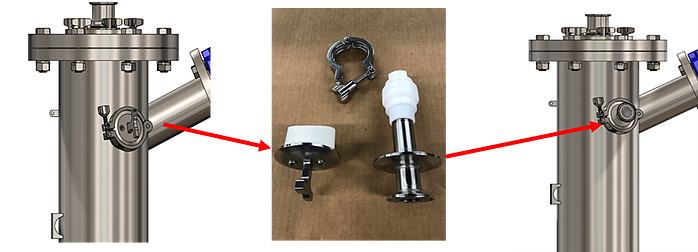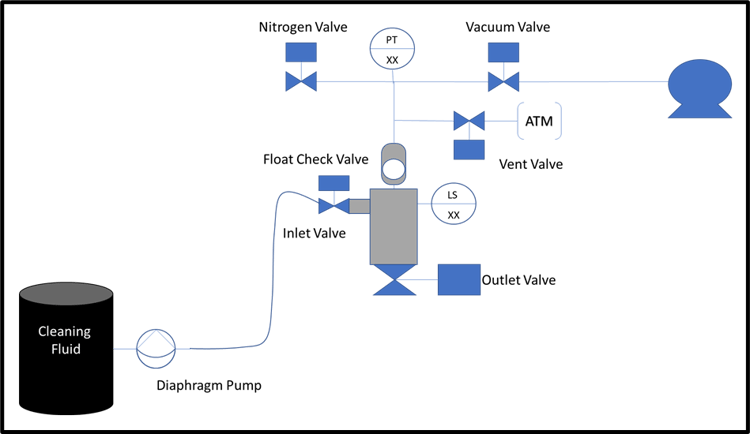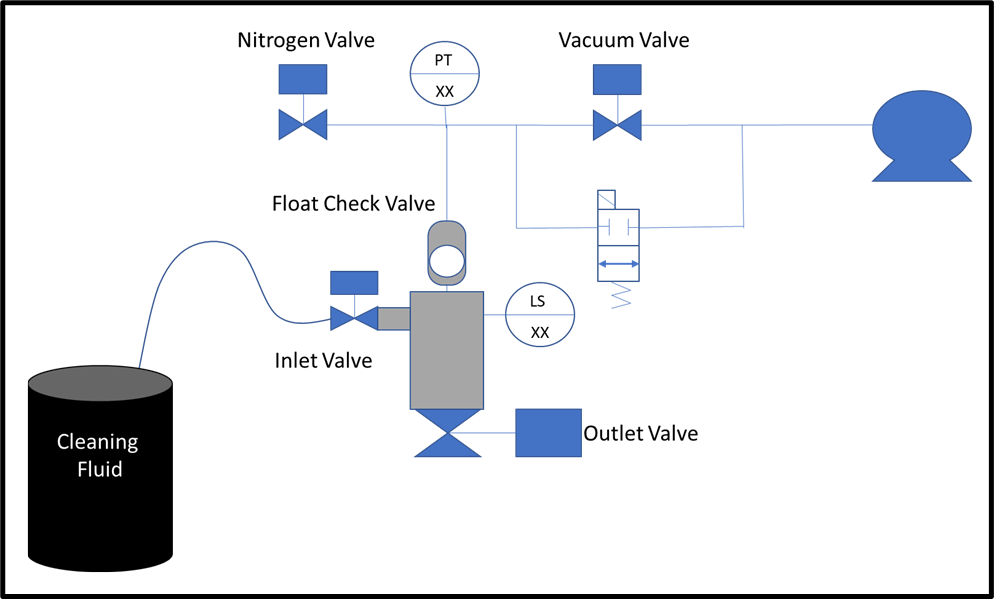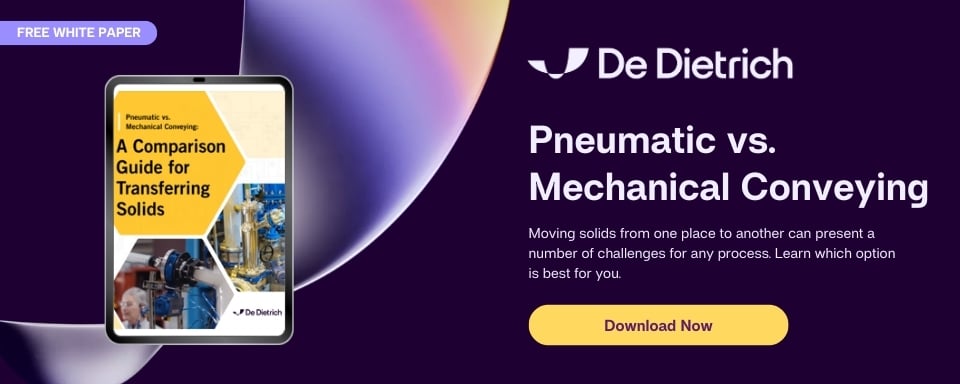Cleaning a Dense Phase Vacuum Conveying System
.jpg?width=300&height=450&name=20210727_ddps_4ML0057%20(1).jpg) When it comes to pneumatic conveying, a question that is often asked is “How do you clean the system?” Cleaning a pneumatic conveying system can be done a few different ways and depends on your process and product.
When it comes to pneumatic conveying, a question that is often asked is “How do you clean the system?” Cleaning a pneumatic conveying system can be done a few different ways and depends on your process and product.
Reasons for Cleaning
Why would you need or want to clean the system? The most common reasons are to:
- Provide individual batch integrity when manufacturing several quantities of the same product.
- Avoid cross-contamination when sequentially manufacturing different products using the same equipment
- Prevent material degradation due to prolonged exposure to the ambient environment (i.e. air, moisture, heat, etc.)
Types of Cleaning
There are many ways to clean a pneumatic conveying system. Some are more traditional, some are less common, and some are almost totally custom. Our focus here will be on the more conventional methods, those being manual cleaning, using an abrasive or coarse material, and using a liquid solvent or detergent. Please keep in mind that some methods might not work for all types of pneumatic conveying systems depending upon the level of cleanliness that is desired or acceptable.
1. Manual Cleaning
The first and most basic option is manually disassembling and cleaning a system. This option is likely the most labor intensive and requires the greatest amount of time. That being said, it will also likely guarantee the highest level of cleanliness. This option may make sense when using a system with the following parameters:
- Short transfer distance
- Transfer line is a flexible hose
- Hose/piping connections are quick-connect or designed for tool-free disassembly
- Solids receiver is relatively small, light and easily accessible
DDPS offers easy-to-clean versions of the Powder Pump system. Contact us for more information.
2. Using an Abrasive or Coarse Material
This method is most commonly employed when a system is used to convey multiple materials. In order to purge as much residual material from the system as possible, it is often helpful to run the most abrasive or most granular materials last. This method can assist in removing some of the more cohesive materials from the walls of the transfer line and other system components. In addition, the abrasive materials will degrade the transfer line less quickly than normal since its friction against those components will be mitigated by the other materials in the pipe instead of rubbing directly on the hose or pipe walls.
3. Using a Liquid Solvent or Detergent
The final option we'll discuss involves cleaning with liquids. Various liquids can be used for this procedure including water, cleaning/caustic solutions, or solvents. Note: When handling solvents, additional considerations for system design may be required. Contact DDPS to discuss your solvent cleaning needs.
There are various ways liquid can be introduced into the system for cleaning purposes.
- Insertable Spray Ball
- Diaphragm Pump
- Vacuum Pump
Insertable Spray Ball
The first and simplest method involves removing the tri-clamp PTFE plug that is included in a side-wall port on the Powder Pump body and inserting a properly designed, DDPS-supplied spray-ball in its place (see Figure 1 below). This is a dynamic spray ball that provides a 360° spray pattern and is strategically located to provide optimum coverage of the inside of the Powder Pump chamber.
In most cases, the transfer hose should be removed from the inlet valve connection and a tri-clamp cap attached to the valve’s inlet adapter. This will allow the cleaning fluid to contact all internal valve surfaces and contain the used wash fluid so that it drains into the receiving vessel on which the system is installed.

Remove Contoured Plug & Insert Spray Ball
A separate Cleaning Switch on a control panel can then be engaged. This will automatically open the inlet and outlet butterfly valves so their disc and seats can be thoroughly wetted and cleaned.
Cleaning fluid can then be supplied to the spray ball at the specified flow and pressure. The cleaning fluid will contact all internal surfaces of the Powder Pump unit and drain out the open discharge valve into the receiving vessel from which it can be drained and disposed of properly.
System washing can continue for as long as desired until the cleaning fluid supply is stopped. The spray ball can then be removed and the contoured plug re-inserted and secured.
Turning off the cleaning function will automatically close the inlet and outlet valves. The tri-clamp cap on the inlet adapter can then be removed, and the transfer hose reattached. Note: When cleaning with the spray ball only, the transfer hose must be cleaned separately or exchanged if removal of residual material from powder transfer is desired.
Diaphragm Pump
Another simple and cost-effective option is to use a diaphragm pump to introduce the cleaning fluid. Although DDPS does not normally provide the diaphragm pump, we can help review the process and ensure all necessary valves and instrumentation required to properly vent gas from the system and protect other devices are provided. The use of a level sensor is required to detect when cleaning fluid has properly filled the Powder Pump chamber. This method is illustrated in Figure 2 below:

Figure 2 - Cleaning with a Diaphragm Pump
Vacuum Pump
Another method of cleaning is accomplished by including a DDPS supplied liquid float check valve and vacuum control valve with the system’s purchase and installation. These components will allow the system to draw cleaning fluid from a reservoir using the suction lance and transfer hose. Note: This option also allows the transfer hose to be wetted and cleaned during system washing.
A separate Cleaning Switch on the control panel is used to change the operating mode from Powder Transfer to Wash-in-Place (WIP). Once the WIP mode is selected, the operator can start the system just like a normal Powder Transfer sequence.
However, when in WIP mode, the main vacuum valve would remain closed and a smaller automated valve running in parallel with the vacuum valve is used to control the vacuum level in the system. This restriction in the vacuum line helps control the flow rate of the cleaning liquid. The vacuum is monitored by a pressure transmitter on the utility cross to keep the vacuum level within a certain range. This range can be adjusted based on elevation and on the type of liquids being used.
In addition to the pressure transmitter, an internal level probe is used to detect the liquid (same level probe is also used for level detection during powder transfer) inside the chamber. Once cleaning fluid is detected by the sensor, a delay timer allows the chamber to fill completely before the fill cycle is stopped.
In the event the level sensor fails or the delay timer has been increased too much, a secondary float check valve is in place to prevent further progress of fluid through the vacuum line. This float check valve is mounted to the top head of the Powder Pump. See Figure 3 below for typical system schematic.

Figure 3 - Cleaning with a Vacuum Pump
Hopefully, this post gave you a little more insight into the different options available for cleaning a dense phase pneumatic conveying system. Whether your concern is cross-contamination, or your product has difficult characteristics that can negatively affect system performance for later batches, keeping your system clean is a general housekeeping best practice regardless of what material you are handling. For more information on our Powder Pump and how it can be a potential fit for your powder or solids handling needs, contact our team for more information.
